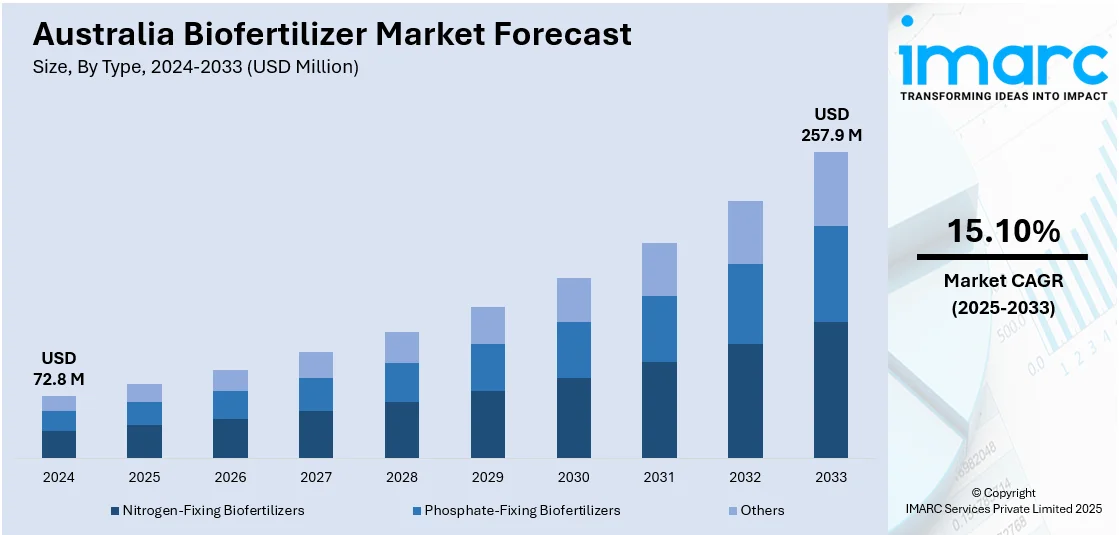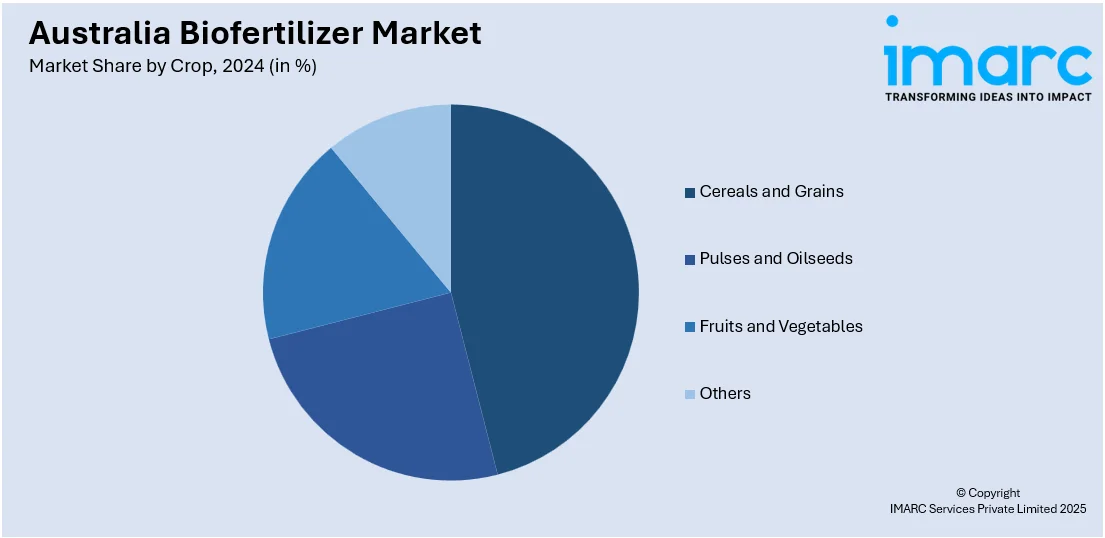
Australia Biofertilizer Market Size, Share, Trends and Forecast by Type, Crop, Microorganism, Mode of Application, and Region, 2025-2033
Australia Biofertilizer Market Overview:
The Australia biofertilizer market size reached USD 72.8 Million in 2024. Looking forward, IMARC Group expects the market to reach USD 257.9 Million by 2033, exhibiting a growth rate (CAGR) of 15.10% during 2025-2033. The market is driven by rising demand for sustainable farming, government support for organic agriculture, growing consumer preference for chemical-free produce, and innovations in microbial technology that improve soil health and crop yields.
|
Report Attribute
|
Key Statistics
|
|---|---|
|
Base Year
|
2024 |
|
Forecast Years
|
2025-2033
|
|
Historical Years
|
2019-2024
|
| Market Size in 2024 | USD 72.8 Million |
| Market Forecast in 2033 | USD 257.9 Million |
| Market Growth Rate 2025-2033 | 15.10% |
Australia Biofertilizer Market Trends:
Demand for Sustainable and Organic Farming
Australia's growing shift towards sustainable agriculture is significantly boosting the Australia biofertilizer market growth. Farmers and agribusinesses are increasingly aware of the environmental impact of chemical fertilizers, such as soil degradation, water pollution, and biodiversity loss. Biofertilizers offer a natural and eco-friendly alternative by enriching soil with beneficial microorganisms that enhance nutrient availability. With organic farming gaining traction among producers and consumers alike, biofertilizers align well with certification requirements and long-term soil health goals. The sustainability focus is particularly strong in regions experiencing climate stress, where resilient, regenerative practices are necessary. As a result, more farms are adopting organic inputs to ensure both environmental stewardship and long-term agricultural productivity.

To get more information on this market, Request Sample
Growth in the Organic Food Market
Australia's organic food market has experienced steady growth, driven by consumer demand for health-conscious, environmentally friendly produce. This surge in demand places pressure on farmers to adopt certified organic practices, including the use of biofertilizers, creating a positive impact on the Australia biofertilizer market outlook. Unlike chemical fertilizers, biofertilizers support organic certification standards and are safer for long-term soil and human health. Supermarkets, restaurants, and export markets increasingly favor organic produce, incentivizing growers to shift to natural farming inputs. Additionally, rising awareness of the health impacts of pesticide and chemical residue in food has pushed both consumers and producers toward bio-based solutions. This trend directly fuels the need for consistent, high-quality biofertilizers across various agricultural sectors.
Advancements in Microbial and Soil Health Technologies
Technological innovation plays a key role in fueling the Australia biofertilizer market share. Advances in microbiology and soil science have led to the development of more effective biofertilizer strains that improve nutrient uptake, boost plant immunity, and enhance crop resilience. These products not only replenish soil microbial diversity but also improve soil structure and fertility over time. Modern formulations offer better shelf life, adaptability to different crop types, and ease of application, making them more appealing to commercial growers. Research institutions and ag-tech startups in Australia continue to refine biofertilizer technologies, ensuring better compatibility with diverse Australian soil conditions and farming systems, ultimately supporting broader market adoption.
Australia Biofertilizer Market Segmentation:
IMARC Group provides an analysis of the key trends in each segment of the market, along with forecasts at the regional level for 2025-2033. Our report has categorized the market based on type, crop, microorganism, and mode of application.
Type Insights:
- Nitrogen-Fixing Biofertilizers
- Phosphate-Fixing Biofertilizers
- Others
The report has provided a detailed breakup and analysis of the market based on the type. This includes nitrogen-fixing biofertilizers, phosphate-fixing biofertilizers, and others.
Crop Insights:

- Cereals and Grains
- Pulses and Oilseeds
- Fruits and Vegetables
- Others
A detailed breakup and analysis of the market based on the crop have also been provided in the report. This includes cereals and grains, pulses and oilseeds, fruits and vegetables, and others.
Microorganism Insights:
- Cyanobacter
- Rhizobium
- Phosphate Solubilizing Bacteria
- Azotobacter
- Others
A detailed breakup and analysis of the market based on the microorganism have also been provided in the report. This includes cyanobacter, rhizobium, phosphate solubilizing bacteria, azotobacter, and others.
Mode of Application Insights:
- Seed Treatment
- Soil Treatment
- Others
A detailed breakup and analysis of the market based on the mode of application have also been provided in the report. This includes seed treatment, soil treatment, and others.
Regional Insights:
- Australia Capital Territory & New South Wales
- Victoria & Tasmania
- Queensland
- Northern Territory & Southern Australia
- Western Australia
The report has also provided a comprehensive analysis of all the major regional markets, which include Australia Capital Territory & New South Wales, Victoria & Tasmania, Queensland, Northern Territory & Southern Australia, and Western Australia.
Competitive Landscape:
The market research report has also provided a comprehensive analysis of the competitive landscape. Competitive analysis such as market structure, key player positioning, top winning strategies, competitive dashboard, and company evaluation quadrant has been covered in the report. Also, detailed profiles of all major companies have been provided.
Australia Biofertilizer Market Report Coverage:
| Report Features | Details |
|---|---|
| Base Year of the Analysis | 2024 |
| Historical Period | 2019-2024 |
| Forecast Period | 2025-2033 |
| Units | Million USD |
| Scope of the Report |
Exploration of Historical Trends and Market Outlook, Industry Catalysts and Challenges, Segment-Wise Historical and Future Market Assessment:
|
| Types Covered | Nitrogen-Fixing Biofertilizers, Phosphate-Fixing Biofertilizers, Others |
| Crops Covered | Cereals And Grains, Pulses And Oilseeds, Fruits And Vegetables, Others |
| Microorganisms Covered | Cyanobacter, Rhizobium, Phosphate Solubilizing Bacteria, Azotobacter, Others |
| Mode of Applications Covered | Seed Treatment, Soil Treatment, Others |
| Regions Covered | Australia Capital Territory & New South Wales, Victoria & Tasmania, Queensland, Northern Territory & Southern Australia, Western Australia |
| Customization Scope | 10% Free Customization |
| Post-Sale Analyst Support | 10-12 Weeks |
| Delivery Format | PDF and Excel through Email (We can also provide the editable version of the report in PPT/Word format on special request) |
Key Questions Answered in This Report:
- How has the Australia biofertilizer market performed so far and how will it perform in the coming years?
- What is the breakup of the Australia biofertilizer market on the basis of type?
- What is the breakup of the Australia biofertilizer market on the basis of crop?
- What is the breakup of the Australia biofertilizer market on the basis of microorganism?
- What is the breakup of the Australia biofertilizer market on the basis of mode of application?
- What is the breakup of the Australia biofertilizer market on the basis of region?
- What are the various stages in the value chain of the Australia biofertilizer market?
- What are the key driving factors and challenges in the Australia biofertilizer market?
- What is the structure of the Australia biofertilizer market and who are the key players?
- What is the degree of competition in the Australia biofertilizer market?
Key Benefits for Stakeholders:
- IMARC’s industry report offers a comprehensive quantitative analysis of various market segments, historical and current market trends, market forecasts, and dynamics of the Australia biofertilizer market from 2019-2033.
- The research report provides the latest information on the market drivers, challenges, and opportunities in the Australia biofertilizer market.
- Porter's five forces analysis assist stakeholders in assessing the impact of new entrants, competitive rivalry, supplier power, buyer power, and the threat of substitution. It helps stakeholders to analyze the level of competition within the Australia biofertilizer industry and its attractiveness.
- Competitive landscape allows stakeholders to understand their competitive environment and provides an insight into the current positions of key players in the market.
Need more help?
- Speak to our experienced analysts for insights on the current market scenarios.
- Include additional segments and countries to customize the report as per your requirement.
- Gain an unparalleled competitive advantage in your domain by understanding how to utilize the report and positively impacting your operations and revenue.
- For further assistance, please connect with our analysts.
 Request Customization
Request Customization
 Speak to an Analyst
Speak to an Analyst
 Request Brochure
Request Brochure
 Inquire Before Buying
Inquire Before Buying




.webp)




.webp)












